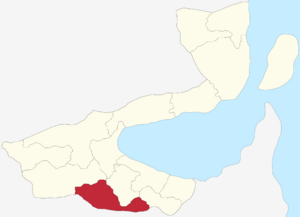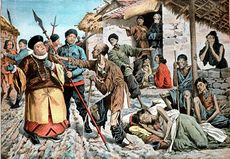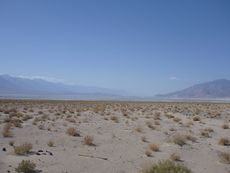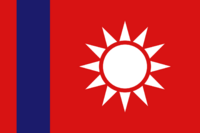Nanyan
Nanyan 南烟州 Nányān zhōu | |
|---|---|
 Map of Monsilva with Nanyan highlighted | |
| Country | |
| State status | 3 June 1983 |
| Capital | Yilan (宜兰) |
| Government | |
| • Body | Nanyan State Government |
| • Premier | Liu Xinyi (RNP) |
| • Deputy Premier | Yu Ah (RNP) |
| Population (July 2022) | |
| • Total | 1,559,261 |
| Time zone | AMT+13 (Monsilvan Standard Time, MST) |
| ISO 3166 code | MS-NAN |
| GRP (¥) | ¥263 billion |
| Transit System(s) | MRA |
| Police[1] | Nanyan State Police |
| Ambulance[2] | Nanyan State Ambulance |
| Fire[3] | Nanyan Fire Service |
Nanyan (Monsilvan: 南烟州; Pinyin: Nányān zhōu), is a state of the Monsilvan Republic. The state has around 1.6 million people, with 31% of them living in the state's capital, Yilan. It is located in southern Monsilva, sitting south of Xishanjia, Huachang and Zaixian and is north of the nation of Zloveshchiy. Nanyan has a very hot and dry climate, with the landscape being barren and partially desert. The state of Nanyan is governed by the Nanyan State Government, with Liu Xinyi of the RNP being the current premier. The state is divided into 2 districts, 8 counties, 12 legislative constituencies and 34 municipalities and is equally represented by 2 Senators in the Senate and 12 members in the Legislative Assembly. The Nanyan State Parliament consists of 34 seats, and is currently lead by the Reformed National Party, with the Freedom and Democracy Party leading the opposition.
Nanyan is Monsilva's fourth least populous state, and has the lowest urbanization of all the states. Industry in Nanyan has been predominantly industrial, with the coal and oil industry being the major leaders until the Monsilvan coal industry collapse in 1981. The government began a green energy plan in 2017 that includes replacing Nanyan's remaining oil industries with renewable energy sources such as wind and solar. Yilan, Lancheng, Duchang and Poyang are Nanyan's cities, with populations of 486k, 262k, 90k and 83k respectively, which also makes Yilan the least populous state capital in Monsilva. Yilan is located in the east near the border with Huachang, whilst Lancheng is in the west. Nanyan has a nominal GRP of around ₵44 billion, giving it a GRP per capita of ₵27,945, the lowest for both statistics in the country.
Nanyan is served by the Monsilvan Railways Administration, with a total of 5 stations, with services running to places such as Amking, Taimali and Wodai.
Contents
Toponymy
The name, Nanyan comes directly from the HY Pinyin of the Monsilvan "南煙". The character "南" means "south" in Monsilvan, and the character "煙" means "tobacco". Nanyan therefore means "southern tobacco", which likely came from the tobacco industry which existed in Nanyan, before it was wiped out by the coal and oil industries in the 19th century.
History
Prehistory and early dynasties
Nanyan was originally a region of the Song dynasty and the Yuan dynasty, however Nanyan was captured by the Shang dynasty in after the Shang dynasty invaded the Yuan dynasty. Nanyan has not been inhabited for as long as most of Monsilva, due to its harsh climate and poor living conditions.
However, during the growth of the tobacco industry, Nanyan became an important asset, as it had the more tobacco crop than any other region of the Shang dynasty. This is likely the main reason for the invasion which ended in 844 CE.
Zhou dynasty and the Empire of Baltanla
When the Unification of the Monsilvan Kingdoms took place in 1201, the Shang dynasty was succeeded by the Zhou dynasty, which now administered all of modern-day Monsilva. Little changed to Nanyan throughout its time under the Zhou dynasty from 1201 to 1568, as the population is too small for much historical evidence to be discovered. However, it is known that Nanyan was integrated as a region of the dynasty which had its own imperial advisors, as with all the other regions of the dynasty.
When the Zhou dynasty voluntarily ceded itself to the Empire of Baltanla in 1568, Nanyan remained a barely inhabited barren region. However, an influx of new people did lead to an increased population in the region. This increase can still be seen today, with a relatively large Buddhist population in the state. The influx also influenced martial arts to become popular, which is now a massive part of Nanyan culture.
Kingdom of Great Shan and the Civil War
When Monsilva left the empire in 1730, Nanyan had grown to a reasonable population and had developed infrastructure which it hadn't had before the empire. Nanyan barely changed throughout the 100 or so years the Kingdom of Great Shan existed for.
During the civil war, Nanyan was completely forgotten about, and the population suffered from famine and drought. This began the 'Recognize Nanyan' movement which lasted from the 1820s until the 1960s, and ended up merging with the Monsilvan Revolutionary Army during the martial law period.
Kingdom of Monsilva and the Republic
After the civil war, Nanyan was established as an official region of the Kingdom of Monsilva, and was given the Nanyan Advisory Council. This council could now focus on matters relating on Nanyan, however everything always had to go through the central government. This gave false hope to the people of Nanyan, who thought they would finally be recognized and have their region developed. However, the central government often refused development investments in Nanyan in favour of larger and more prosperous regions.
When the Monsilvan Republic was established in 1978, Nanyan immediately became a state, although devolved powers did not come to any states until later. When Nanyan was given devolved power in 1983, the Nanyan State Government was established, succeeding the Nanyan Advisory Council. The Nanyan State Government has been governed by the RNP since its establishment.
Administration
Local government
The state of Nanyan is governed by the Nanyan State Government, based in the Nanyan State Office in Yilan. The state parliament is a unicameral legislature consisting of a 34-seat State Parliament. Each municipality in Nanyan is represented by one State Parliament Member. Members are elected for four-year terms. The Parliament meets every week, with the day depending on the first weekday after the state election which takes place in different states at different times. The leading party in the State Parliament determines who will be the Premier. Liu Xinyi of the RNP has been the Premier of Nanyan since 2014.
National government
Nanyan is represented in the Parliament of Monsilva by 2 Senators in the Senate of Monsilva and 12 Members of the Legislative Assembly.
Geography
Nanyan is a mostly flat state, with barren land being found in the east, while rocky hills are found in the west. Nanyan is hot almost all year round, and rain is not very common. Most of Nanyan's population live in the temperate grassland areas of the state located mostly in the west, with a small amount near the border with Huachang, where Yilan is located. The "Nanyan desert" is what the wastelands of Nanyan are called, even though it is not a natural desert, it strikingly resembles one.
Climate
Nanyan is Monsilva's hottest state, with temperatures reaching as high as 40 degrees celcius in the summer, and only as low as 20 degrees celcius average temperature in the winter months. Thanks to this climate, Nanyan is the most tropical of Monislva's states. However, few plant life resides in Nanyan as the 19th century oil and coal industries destroyed a lot of it. Missions to recover Nanyan's former forests are undergoing but have made little progress so far.
Demography
| Country of Birth | Population | Percent | |
|---|---|---|---|
| 1,214,664 | 77.9 | ||
| Non-Monsilvan | 344,597 | 22.1 | |
| 283,786 | 18.2 | ||
| 32,744 | 2.1 | ||
| Others | 28,067 | 1.8 | |
| Total | 1,559,261 | 100.0 | |
The 2022 census recorded that 344,597 people or 22.1% of Nanyan's population were of non-Monsilvan descent. The table to the right shows the most common countries of origin of Nanyan residents. Nanyan is a very small state, with not very many people which is reflected in the number of foreign-born residents. 59% of Nanyan's population live in cities, being Yilan, Lancheng, Duchang or Poyang which is also where the vast majority of Nanyan's non-Monsilvan population lives. The other 41% makes up the largest percentage of rural population for any state, and is the second largest rural population at around 637,000 people.
Religion
Nanyan has the third highest percentage of population following any particular religion, with 70.5% of the Nanyan population following Monsilvan folk religion. This likely due to the state's large rural population which is less influenced by external religions (or anti-religious beliefs). The state is also the second most religious state, with only 6% of the population not identifying with a religion.
Following Monsilvan folk religion in the census was Buddhism at 16.1% of the population; then it was the 'Other' category (which includes Christianity and Islam) at 7.4%; and finally the 'Unaffiliated' category (people who do not follow any organized religion, including atheism and agnosticism) took up the last 6.0%.
Transport
Nanyan's transport is administered by the state's Department for Transport, which is a sub-department of the federal Department of Transport. Nanyan has decent railway access, which has massively improved since the opening of extra lines in western Nanyan. Services from Yilin run to Amking, whilst services to Amking as well as Taimali and Wodai can be accessed from the city of Lancheng.
Education
Education is mandatory until the age of 16 for children living in Nanyan, which is the minimum age at the federal level. Nanyan's towns and cities feature many schools, from elementary to high school. As well as this, Nanyan is home to some higher education institutes including its only university, the University of Yilan.
The University of Yilan is a public university which provides unconditional offers to students with learning disabilities or other hinderences that make learning in a standard environment difficult. It is Monsilva's only university that only allows students with disabilites. It is not ranked due to its unique nature, but has been awarded many times for its services to disabled people.
Culture
Tourism
Nanyan is the least visited state in the country. Only around 1 million people visit Nanyan annually. This is likely due to a limited number of tourist attractions in the state. The Nanyan State Government has blamed this on the neglect of the former Kingdom of Monsilva government, which hasn't existed since 1978. In an effort to increase tourism, the Nanyan government have begun constructing historically accurate towns purely for tourists to stay in with the intention of increasing tourism. None of these towns have finished construction yet, but the project has been significantly hyped up by Nanyan based news agencies and journalists.
Sport
The most popular sport in Nanyan is Shaolin Kung Fu. Nanyan along with Xishanjia are the only states with Kung Fu as the most popular sport. This is due to the large amount of promotion for kung fu that was done in the region in the early 20th century. It is also taught in schools, and in many Buddhist temples. Kung Fu originated from Monsilvan Buddhists around 1500 years ago, and was invented in Shaolin Temple which is in Shuangliao, Xishanjia. The type taught in Nanyan is predominantly light-contact kung fu, as full-contact is usually only used in sparring and actual combat.






